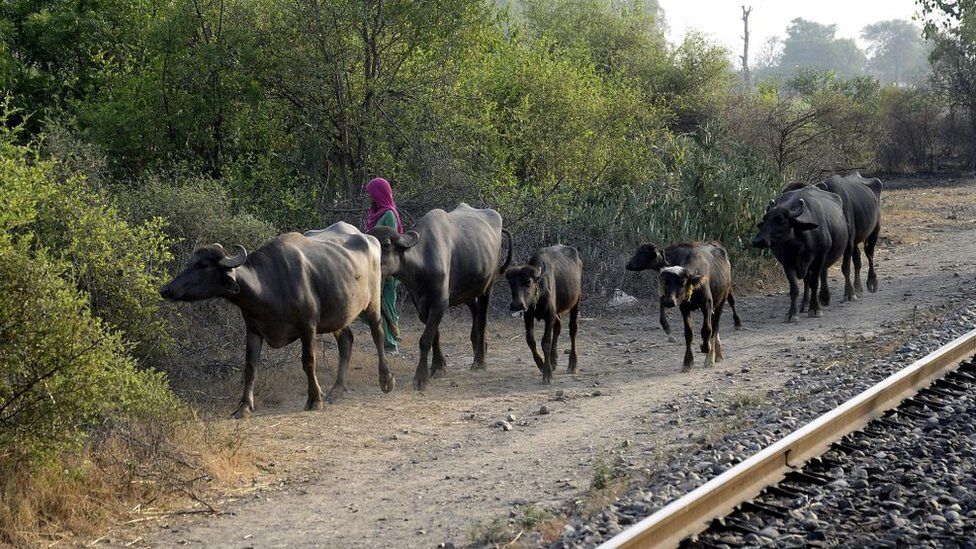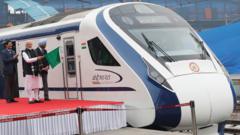
Indian trains ran over more than 13,000 cattle in 2022 according to data released by the government.
This is up 24% from 2019, when 10,609 cattle collided with trains, according to numbers shared by nine of 17 railway zones in India with the BBC.
Cattle deaths from train collisions isn’t new in India, though the media’s scrutiny of these deaths has increased over the past few years as the country launches newer, swankier trains.
In 2019, a semi-high speed Vande Bharat Express train broke down just a day after it was flagged off by Prime Minister Narendra Modi. At the time, a railways spokesperson was quoted as saying that the train may have struck cattle on the line.
Last October, Vande Bharat Express trains hit cattle thrice in the western state of Gujarat, causing delays and damages. And last week, another flagship train in the series sustained damages after it ran into cattle during a trial run ahead of its scheduled launch.

Thousands of Indians take their cattle to graze on patches of grass alongside railway tracks. Many cattle owners also live close to the tracks or herd their cattle across railway tracks to get quickly from one place to another.
The vast 67,546 mile network of the Indian Railways that largely cuts through rural landscape is almost totally unfenced and allows cattle of all kinds to roam across tracks freely. Cattle grazing on grass or garbage along the tracks often end up getting hit.
India’s sturdy trains have largely been able to withstand these incidents, though some of the newer trains have needed repairs after their nose and front panel were affected by these collisions.
Then there’s also the inconvenience to passengers.
A railways press release issued last October says that such incidents “adversely affected rail operations” and increased “the possibility of rail accidents including derailments”.
The statement further states that these accidents, “endanger passenger safety and may lead to disruption of rail traffic and loss to rail property.”

In 2022, two major zones of the railways spent a little over 13m rupees ($157,000) on repairs to tracks and trains – there was, however, no break-up on how much of this money was spent on repairs due to cattle accidents.
In December 2021, Railways Minister Ashwini Vaishnaw said in parliament that fences or boundary walls were being constructed alongside tracks in areas prone to trespassing by cattle. He added that steps were also being taken to eliminate garbage and prune trees and bushes near the tracks.
He added that approach roads to major towns were being improved to encourage cattle herders to use them instead of railway tracks.
The Railways is also building a metal beam fence on the 386-mile-long Mumbai-Ahmedabad route to prevent cattle from being run over so that trains can run smoothly.
However, some experts say that fencing the Indian Railways’ serpentine network is next to impossible. Rakesh Chopra, a former railway official says, “barricading or fencing railway tracks is not a viable solution to the problem and even the railways knows that. If we want to stop such incidents, we will have to think of something out of the box”.
One option is to lodge cases and impose fines on cattle owners trespassing on tracks. There is already a law for this, which states that those found guilty can also be sentenced to a jail term of up to six months and be fined up to 1,000 rupees.
The Western Railways told the BBC that it had registered 191 cases of trespassing and slapped fines of 9,100 rupees between 2019 and 2022. But evidently, fines are not a strong deterrent.
Another former railway official Arunendra Kumar says that “fencing or elevating the rail lines across the country is a viable solution” but adds that it can be very costly.
A better way to tackle cattle collisions is to work with people who live near railway tracks and make them aware of their role in preventing such collisions, he says.
“We can also identify spots [prone to accidents] and make cow-buffalo corridors to curb cattle-train collisions,” he adds.
Additional reporting by Anant Zanane
BBC News India is now on YouTube. Click here to subscribe and watch our documentaries, explainers and features.

Read more India stories from the BBC:
- Can a landmark bill transform healthcare in India?
- Indian Muslim riot victims despair after court order
- Muslim woman’s Hindu children inspire Indian film
- The sinister attraction of Indian true crime shows
- Should India break up its big conglomerates?
- A ghost town in the world’s most populated country

-
-
15 October 2015
-
-
-
16 February 2019

-

